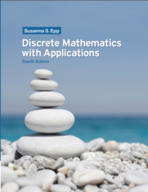Modify Example 1 by supposing that a PIN must not begin
Chapter 9, Problem 20E(choose chapter or problem)
Modify Example 1 by supposing that a PIN must not begin with any of the letters A–M and must end with a digit. Continue to assume that no symbol may be used more than once and that the total number of PINs is to be determined.a. Find the error in the following “solution.”________________“Constructing a PIN is a four-step process.Step 1: Choose the left-most symbol.Step 2: Choose the second symbol from the left.Step 3: Choose the third symbol from the left.Step 4: Choose the right-most symbol.Because none of the thirteen letters from A through M may be chosen in step 1, there are 36 – 13 = 23 ways to perform step 1. There are 35 ways to perform step 2 and 34 ways to perform step 3 because previously used symbols may not be used. Since the symbol chosen in step 4 must be a previously unused digit, there are 10 – 3 = 7 ways to perform step 4. Thus there are 23 • 35 • 34 • 7 = 191,590 different PINs that satisfy the given conditions.”b. Reorder steps 1–4 in part (a) as follows:Step 1: Choose the right-most symbol.Step 2: Choose the left-most symbol.Step 3: Choose the second symbol from the left.Step 4: Choose the third symbol from the left.Use the multiplication rule to find the number of PINs that satisfy the given conditions.Example 1Number of PINs without RepetitionIn Example 2 we formed PINs using four symbols, either letters of the alphabet or digits, and supposing that letters could be repeated. Now suppose that repetition is not allowed.a. How many different PINs are there?________________b. If all PINs are equally likely, what is the probability that a PIN chosen at random contains no repeated symbol?Solutiona. Again think of forming a PIN as a four-step operation: Choose the first symbol, then the second, then the third, and then the fourth. There are 36 ways to choose the first symbol, 35 ways to choose the second (since the first symbol cannot be used again), 34 ways to choose the third (since the first two symbols cannot be reused), and 33 ways to choose the fourth (since the first three symbols cannot be reused). Thus, the multiplication rule can be applied to conclude that there are 36 ;• ;• 35 ;• ;• 34 • ;• ;33 = 1,413,720 different PINs with no repeated symbol.________________b. By part (a) there are 1,413,720 PINs with no repeated symbol, and by Example there are 1,679,616 PINs in all. Thus the probability that a PIN chosen at random contains no repeated symbol is . In other words, approximately 84% of PINs have no repeated symbol.Example 2Number of Personal Identification Numbers (PINs)A typical PIN (personal identification number) is a sequence of any four symbols chosen from the 26 letters in the alphabet and the ten digits, with repetition allowed. How many different PINs are possible?Solution Typical PINs are CARE, 3387, B32B, and so forth. You can think of forming a PIN as a four-step operation to fill in each of the four symbols in sequence. Step 1: Choose the first symbol.Step 2: Choose the second symbol.Step 3: Choose the third symbol.Step 4: Choose the fourth symbol.There is a fixed number of ways to perform each step, namely 36, regardless of how preceding steps were performed. And so, by the multiplication rule, there are 36 ;• ;36 ;• ;36 ;• ;36 = 364 = 1,679,616 PINs in all.
Unfortunately, we don't have that question answered yet. But you can get it answered in just 5 hours by Logging in or Becoming a subscriber.
Becoming a subscriber
Or look for another answer
